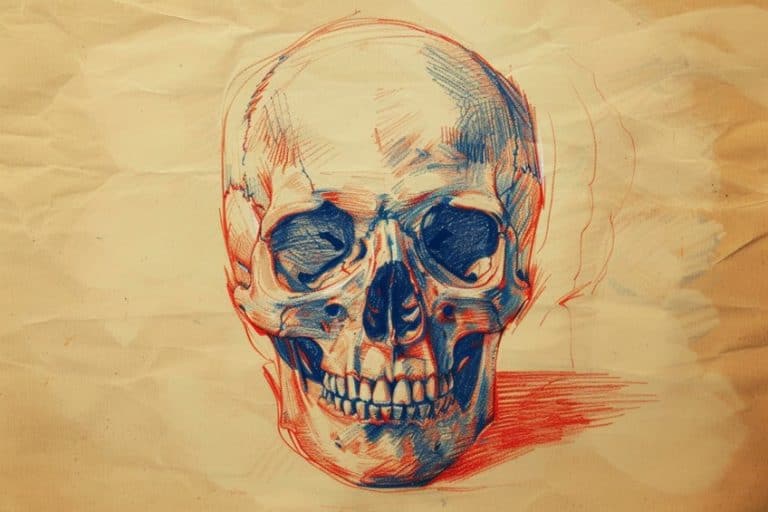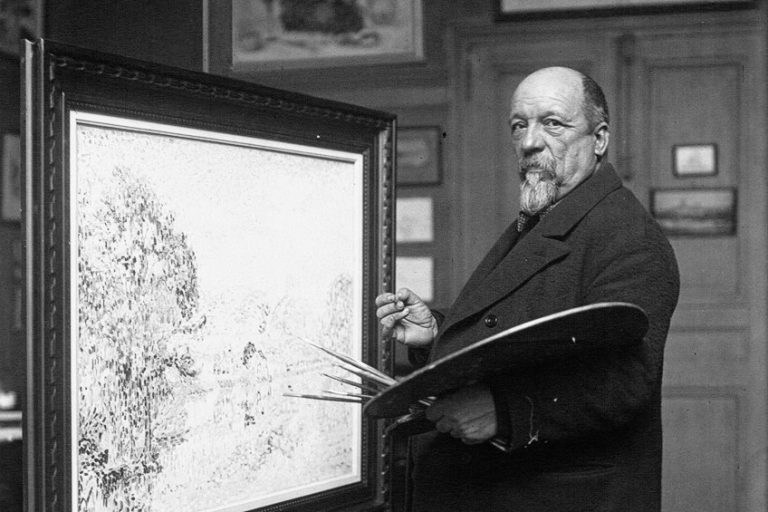Famous Line Artists and Artworks – A List of the 10 Best
There are many artists that use lines in their work, as line is one of the principles of art. However, famous line drawing artists are renowned for their works which exclusively feature linework, using pure lines to represent forms, typically without any shading or backgrounds. Famous line drawings are appreciated for their ability to convey so much expression and emotion simply with lines. Join us as we explore the famous line artists and artworks that defined this style!
Exploring the Most Famous Line Artists and Artworks
Famous line drawings can come in a variety of styles, from figurative to abstract. The more figurative line art examples strive to be more lifelike, representing objects that we recognize in daily life, whereas abstract line art examples are more open to the viewer’s interpretation. Some line drawings artists will produce drawings that are made up of many short lines, sometimes cross-hatching them to simulate shadows and shading, while other line drawings artists will create an entire work with a single continuous line that moves around the page uninterrupted. Who are the most famous artists that use lines, though? Let’s find out as we go through our list of the most famous line artists and artworks.
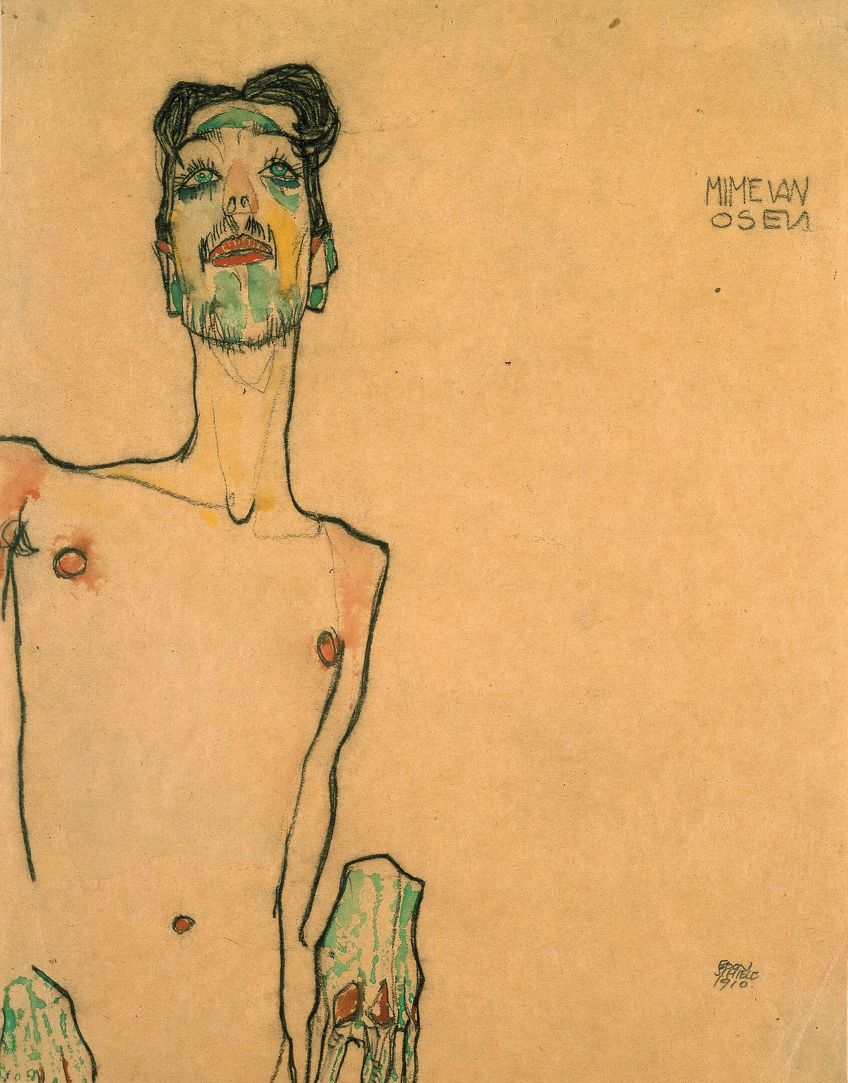
Wassily Kandinsky (1866 – 1944)
| Artist Full Name | Wassily Wassilyevich Kandinsky |
| Nationality | Russian |
| Date of Birth | 16 December 1866 |
| Date of Death | 13 December 1944 |
| Place of Birth | Moscow, Russia |
Russian-born artist, Wassily Kandinsky, is considered by many to be among the forefathers of abstract art. His distinct use of line in his art was an important aspect of his artistic vision, serving to define the abstract style for which he is recognized. Many line art examples by Kandinsky are notable for their expressive fluidity. Line, he felt, could convey thoughts and emotions just as powerfully as form or color, and he employed it as one of the primary forms of expression in his works of art.
Kandinsky’s lines were generally bold and thick in his early artworks, producing an impression of dynamism on the canvas.
Transverse Line (1923) by Wassily Kandinsky
| Artist | Wassily Kandinsky |
| Date Completed | 1923 |
| Medium | Oil on canvas |
| Dimensions (cm) | 140 x 200 |
| Location | Kunstsammlung Nordrhein-Westfalen, Dusseldorf, Germany |
Kandinsky was a prominent theorist driving the discussion surrounding line drawing as an important member of the faculty of the Bauhaus, the Weimar Republic’s art and design school. His Transverse Line, which he produced in 1923, incorporates a variety of lines, shapes, and colors. Kandinsky elaborated on the intricate link between the elements from an exact theoretical viewpoint. This famous line drawing departs substantially from his earlier works, which emphasized post-Impressionistic quasi-religious themes and painterly aesthetics. Along with his drawings, he also distributed theoretical volumes in which he theorized and elaborated on the amazing effects of the straight line and its interplay with the other fixed components of a composition.
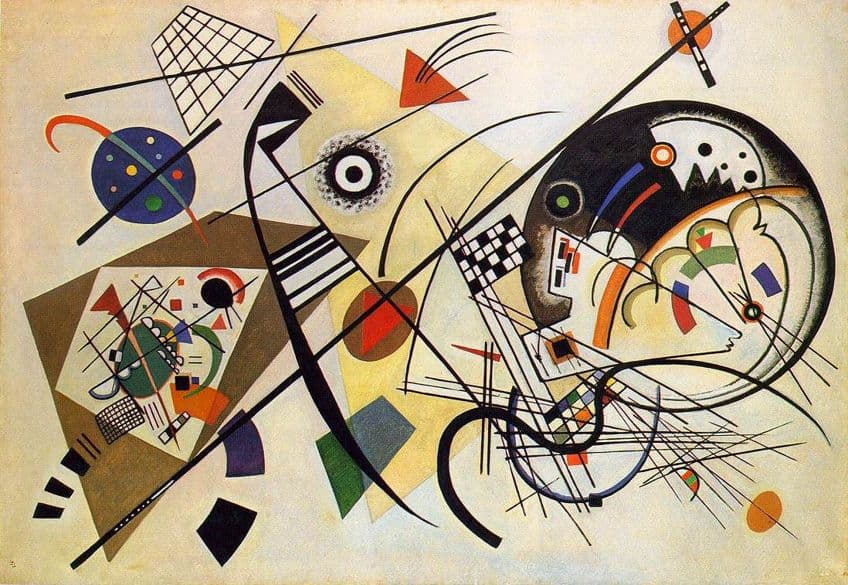
Henri Matisse (1869 – 1954)
| Artist Full Name | Henri Matisse |
| Nationality | French |
| Date of Birth | 31 December 1869 |
| Date of Death | 3 November 1954 |
| Place of Birth | Le Cateau-Cambrésis, France |
Matisse spent an extensive amount of time experimenting with line art. He employed the expressive power of line gestures to portray significantly intimate subjects such as naked bodies, the feminine form, and mythology. Painting started taking a physical toll on the artist’s body by the late 1940s, so he concentrated on his trademark ink drawings for that period of time. Matisse saw his famous line drawings as quick and expressive exercises that conveyed the very essence and emotions stirred in him by his subject.
Matisse used the drawings to iron out intricate ideas, crystallizing them into linear form with immaculate dexterity.
Self-Portrait (1944) by Henri Matisse
| Artist | Henri Matisse |
| Date Completed | 1944 |
| Medium | Lithograph |
| Dimensions (cm) | 53 x 38 |
| Location | Metropolitan Museum of Art, New York City, United States |
Henri Matisse was a line drawing master, producing numerous artworks in this medium during his career. Matisse’s line drawings stand out for their fluidity, beauty, and expressiveness. He typically employed line drawing to simplify his subjects’ forms. This famous line drawing is done in a loose style, with thin lines that capture Matisse’s hair and facial characteristics. Despite the bare-bones nature of the line drawing, the artist’s self-portrait conveys a tremendous deal of character and individuality. His features are drawn with efficiency and accuracy, portraying his distinctive gaze.
Paul Klee (1879 – 1940)
| Artist Full Name | Paul Klee |
| Nationality | Swiss-German |
| Date of Birth | 18 December 1879 |
| Date of Death | 29 June 1940 |
| Place of Birth | Münchenbuchsee, Switzerland |
Paul Klee was a German artist born in Switzerland who was a member of the Bauhaus art and design school. He was one of the most influential artists working with the school, and his work helped shape its distinct approach to art and design. While at the Bauhaus, Klee wrote a textbook packed with numerous concepts and diagrams about the unlimited possibilities of employing lines successfully in one’s artwork. This book comprised five full sheets brimming with detailed diagrams, notes, and hand-drawn models of his line theories, explaining his thoughts regarding how and where to use the line in compositions and its limitless permutations.
The goal was to definitively gather the concepts into a pseudo-science textbook on the topic.
Burdened Children (1930) by Paul Klee
| Artist | Paul Klee |
| Date Completed | 1930 |
| Medium | Graphite, crayon, and ink on paper on board |
| Dimensions (cm) | 65 x 45 |
| Location | Tate Museum of Art, London, United Kingdom |
This famous line drawing depicts how the artist developed aspects of the fundamental ideas he established in his books. He started where every pictorial form begins: with a “point that moves”. This sketch depicts the transition from a singular point to a continuous line, which results in planar structures. It is made up of a nearly continuous line that forms a succession of interlocking, round-cornered boxes. Klee proceeded to add eyes and stick legs to the figures to give them human characteristics. Klee’s use of thick contours on the two figures was rare, a feature most commonly linked with his artwork from the late 1930s. The heavy black lines, though, could be one of the reasons for the drawing’s title.
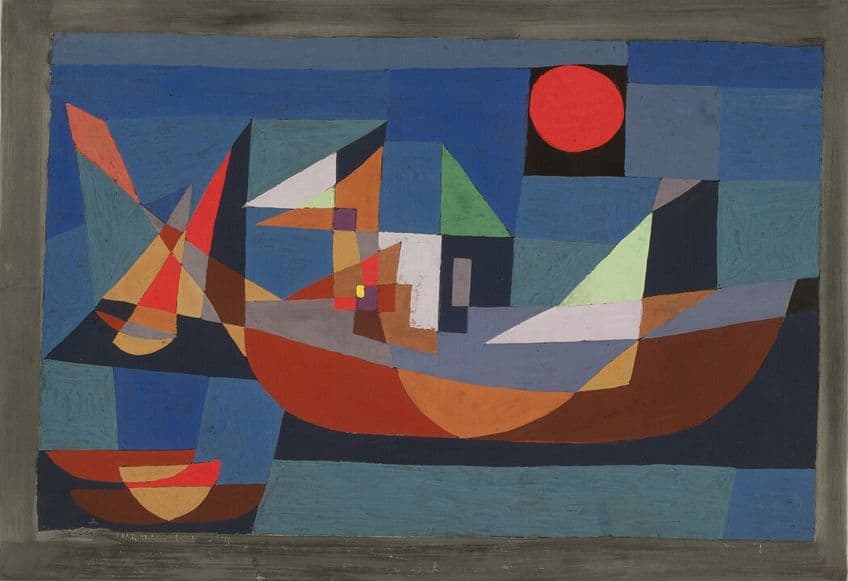
Pablo Picasso (1881 – 1973)
| Artist Full Name | Pablo Ruiz Picasso |
| Nationality | Spanish |
| Date of Birth | 25 October 1881 |
| Date of Death | 8 April 1973 |
| Place of Birth | Málaga, Spain |
Of course, everyone knows about Picasso’s paintings, but he was also a very renowned and adept line artist. Picasso’s famous line drawings were produced with either chalk or pencil and were usually depicted in one unbroken fluid line carrying a great deal of visual information with the seamless economy, brilliantly capturing a myth, an animal, a lady, flowers, and other motifs. Picasso’s simple drawings, evocative of calligraphic strokes, revealed a lighthearted side to the artist, with a degree of direct spontaneity not typically found in his paintings.
His kinetic motions captured the essence of his many topics, instantly condensing their very forms into lines of fluid shape and motion.
Portrait of Diaghilev and Seligsberg (1917) by Pablo Picasso
| Artist | Pablo Picasso |
| Date Completed | 1917 |
| Medium | Pencil |
| Dimensions (cm) | 65 x 54 |
| Location | Musée Picasso, Paris, France |
This famous line drawing was inspired by a photograph taken by Jean de Strelecki. Picasso’s formally attired friends Alfred Seligsberg and Sergei Pavlovich Diaghilev are depicted in this 1917 drawing. The outlines of the people only interact with the blank page of the paper, comparable to the aesthetic of the magazine portraiture in fashion at the time. One of the gentlemen portrayed, Sergei Pavlovich Diaghilev, was a renowned art critic and impresario from Russia, and the founder of a prominent dance company in Paris in the early years of the 20th century. Diaghilev is widely acknowledged to be among the most influential personalities in ballet and modern art history.
Georgia O’Keeffe (1887 – 1986)
| Artist Full Name | Georgia Totto O’Keeffe |
| Nationality | American |
| Date of Birth | 15 November 1887 |
| Date of Death | 6 March 1986 |
| Place of Birth | Sun Prairie, Wisconsin, United States |
Georgia O’Keeffe’s artwork is compelling because she mastered the fundamental elements of art: color, composition, and of course, line. Her works emphasize the importance of line in her workflow and output, from preparatory line drawings to the fluid, seemingly easy markings that establish parts of her canvas and split her compositions into vibrant color zones.
In O’Keeffe’s artwork, we observe an artist trying to push the boundaries, sometimes literally, with lines running off the canvas’s edge, yet always manages to preserve a sense of stability and create visually fascinating compositions.
Blue Lines X (1916) by Georgia O’Keeffe
| Artist | Georgia O’Keeffe |
| Date Completed | 1916 |
| Medium | Graphite and watercolor on paper |
| Dimensions (cm) | 63 x 48 |
| Location | Metropolitan Museum of Art, New York City, United States |
This famous line drawing depicts an artist in transition. O’Keeffe was departing from the more classical art studies she pursued as a student and strived to make her own path. Her drawings initially attracted others to her innate ability, but her technical ability was only combined with creative thinking later on, once she began to explore other ideas. O’Keeffe was still in the early stages of finding her own unique style and was only beginning to gain her confidence as an artist when this work of art was created in the 1910s.

Egon Schiele (1890 – 1918)
| Artist Full Name | Egon Schiele |
| Nationality | Austrian |
| Date of Birth | 12 June 1890 |
| Date of Death | 31 October 1918 |
| Place of Birth | Tulln, Austria |
Egon Schiele is one of today’s most well-known artists. His sexual and profoundly psychological portraits, countless studies of female nudity, and depiction of the human body represented one of art history’s significant shifts. Schiele’s direct and raw creative output is widely recognized and distinctive, thanks to his elegant black line and intense expression.
His drawings and paintings of the entwined body, regarded as being among the most famous drawing line artists, represent the concept that a single black line can be considered both a sketch and a completed piece of art.
Self-Portrait (1912) by Egon Schiele
| Artist | Egon Schiele |
| Date Completed | 1912 |
| Medium | Gouache and pencil on paper |
| Dimensions (cm) | 51 x 34 |
| Location | Neue Galerie, New York City, United States |
Egon Schiele’s line drawings are known for their expressive force and incredible intensity when capturing the human figure. This 1912 self-portrait is an excellent example of Schiele’s technique and style. Schiele is seen in this famous line drawing glaring out at the observer with a strong, almost aggressive glare as if almost daring the viewer to look away. Schiele was said to be deeply interested in psychoanalysis, and his self-portraits, in particular, are evidence of his desire for self-analysis as well as a fair amount of narcissism. His portraits were said to present viewers with deeper insight into the human condition, and his line works were referred to as “meaningful marks” by those within the field of line drawing.
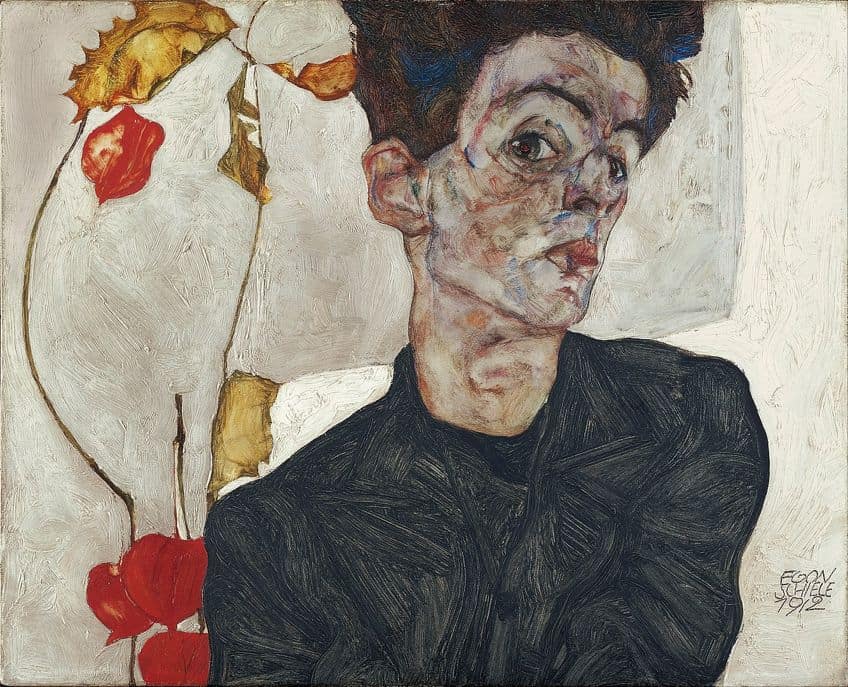
Al Hirschfeld (1903 – 2003)
| Artist Full Name | Albert Hirschfeld |
| Nationality | American |
| Date of Birth | 21 June 1903 |
| Date of Death | 20 January 2003 |
| Place of Birth | St. Louis, Missouri, United States |
Al Hirschfeld’s use of line was both confident and fluid, lending movement and vitality to his works. This famous line drawing artist was able to express the essence of his characters with only a few simple lines, typically accentuating their physical characteristics in a comical and charming way. Hirschfeld’s famous line drawings were ideal for his subject matter, which consisted of caricatures of renowned musicians, actors, and other entertainers.
His line drawings became a popular part of the entertainment business because of their distinct style.
Ringo Starr Visits Hollywood (2002) by Al Hirschfeld
| Artist | Al Hirschfeld |
| Date Completed | 2002 |
| Medium | Lithograph on Japon Paper |
| Dimensions (cm) | 57 x 40 |
| Location | RoGallery, Long Island City, United States |
Many of Hirschfeld’s famous line drawings featured celebrities, and this one is no exception. This time, we are treated to the artist’s caricature of the Beatles drummer, Ringo Starr. With very few lines, he has managed to perfectly capture Starr’s likeness, portrayed in front of the Hollywood Hills. The hills in the background provide the otherwise black-and-white image with its only color, rendered in a single flat shade of green.
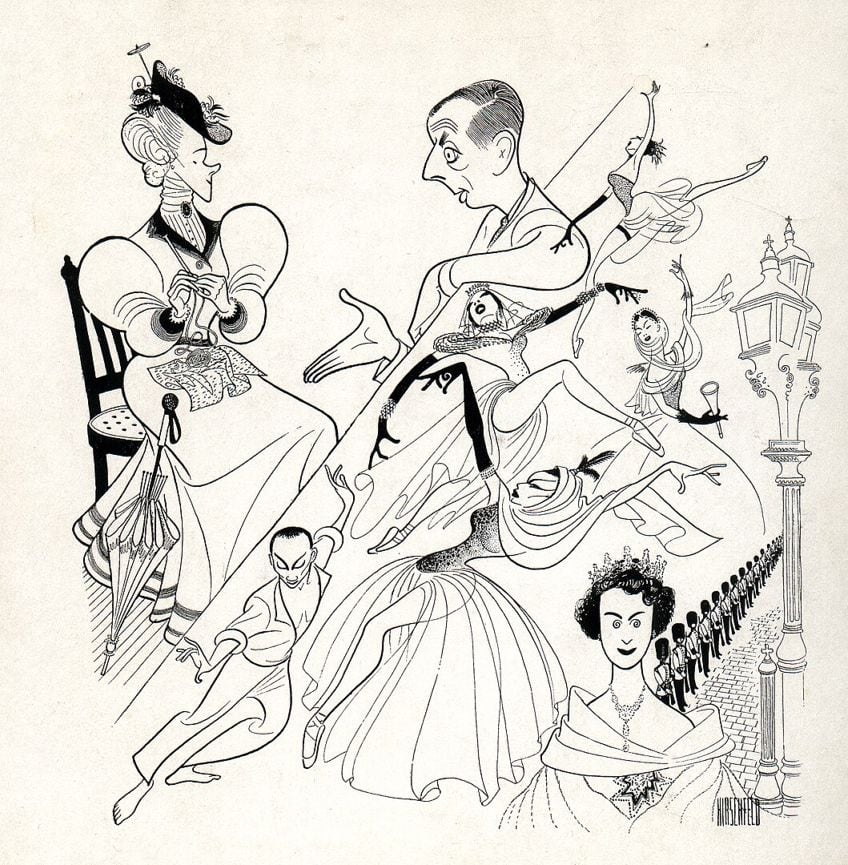
Andy Warhol (1928 – 1987)
| Artist Full Name | Andy Warhol |
| Nationality | American |
| Date of Birth | 6 August 1928 |
| Date of Death | 22 February 1987 |
| Place of Birth | Pittsburgh, Pennsylvania, United States |
Line art can arise and develop from a wide range of creative forms. Andy Warhol, the famed pop artist known for his paintings and silkscreens that highlighted what was considered a typical portrayal of 1960s American culture, was also a commercial illustrator at one point in his career. His famous line drawings of footwear and cats demonstrate how vital drawing was to his artistic technique. The pictures were created using the ‘blotted line’ technique, which is a mixture of drawing and basic printmaking.
On his second day of introducing himself to various New York-based publishers in the hopes of finding work, Warhol acquired his first commercial illustration assignment – to make line drawings of shoes for Glamour Magazine.
Shoe (1954) by Andy Warhol
| Artist | Andy Warhol |
| Date Completed | 1954 |
| Medium | Ink and graphite on paper |
| Dimensions (cm) | 29 x 26 |
| Location | Long-Sharp Gallery, Indianapolis, United States |
One of Warhol’s first assignments as a professional commercial graphic artist was to illustrate shoes supplied to him. When he returned the following day with drawings of the shoes, Glamour’s art director, Tina Fredericks, had to explain that it wasn’t about sketching the shoes with worn characteristics, but about drawing new, untouched shoes. The shoes he used as models started to pile up in his flat, and it is claimed that his fascination for shoe collecting developed during these years. In the 1950s, Warhol was also responsible for revitalizing I. Miller’s advertising campaign, notably through his famous line drawings of shoes, creating over 300 shoe drawings for the company.
Sherrie Levine (1947 – Present)
| Artist Full Name | Sherrie Levine |
| Nationality | American |
| Date of Birth | 17 April 1947 |
| Date of Death | Present |
| Place of Birth | Hazleton, Pennsylvania, United States |
Sherrie Levine’s artwork addresses many of the principal characteristics of postmodern art, including the concepts of authenticity, originality, and identity. She rose to fame as one of the members of the Pictures Generation, an art collective based in New York in the late 1970s and early 1980s whose works investigated the symbolic structures underpinning mass-circulated imagery, and, in a number of instances, appropriated them and infused them with fresh, carefully inflected meaning.
Ever since then, she has developed a distinct and complex portfolio in a range of media (including painting, photography, and sculpture) that directly reproduces works and themes from the historical canon of Western art.
Untitled (After Joan Miró) (1985) by Sherrie Levine
| Artist | Sherrie Levine |
| Date Completed | 1985 |
| Medium | Pencil and watercolor on pencil |
| Dimensions (cm) | 35 x 28 |
| Location | Museum of Modern Art, New York City, United States |
Levine produced a line drawing that resembles one of Joan Miró’s classic compositions in this famous line drawing from 1985. In this artwork, her line work is an almost exact replica of Miró’s original piece, featuring sinuous lines which impart energy and motion on the surface of the canvas. The lines are delicate and thin, but precisely rendered and controlled, perfectly recreating the subtle nuances of Miró’s original painting. Levine makes a statement about the inherent qualities of art and creativity through the creation of a line drawing that mirrors Miró’s composition. She argues that originality isn’t always the most essential component of art and that it’s possible to make significant and impactful works by revising and recontextualizing earlier works.
Keith Haring (1958 – 1990)
| Artist Full Name | Keith Allen Haring |
| Nationality | American |
| Date of Birth | 4 May 1958 |
| Date of Death | 16 February 1990 |
| Place of Birth | Reading, Pennsylvania, United States |
American-born Keith Haring was a street artist and social activist best recognized for his trademark, graffiti-inspired style. His use of line was a defining feature of his artwork, helping cement him as one of the 20th century’s most influential painters. His lines are typically thick, bold, and dynamic, and look as if they were created quickly and intuitively. Haring’s passion for street art and pop culture was also evident in his distinct use of linework.
He felt that artistic expression should be accessible to everybody, and his application of bold, graphic lines was a manner of creating art that a wide audience could understand and appreciate.
Best Buddies Pop Shop 1 (1987) by Keith Haring
| Artist | Keith Haring |
| Date Completed | 1987 |
| Medium | Silkscreen |
| Dimensions (cm) | 38 x 30 |
| Location | Masterworks Fine Art Gallery, Palo Alto, California, United States |
This famous line drawing by Keith Haring is the first print in the artist’s portfolio series titled Pop Shop 1, which was first released in 1987. Two of Haring’s trademark black line figures appear in this silkscreen print. One orange and one yellow human being are shown with their arms around each other. The portfolio’s four prints all use the same limited color palette of orange, yellow, purple, and teal. Haring focused on issues like morality, humanity, creation, death, sex, and violence. The arrangement of the two characters in this print symbolizes the friendship of two individuals
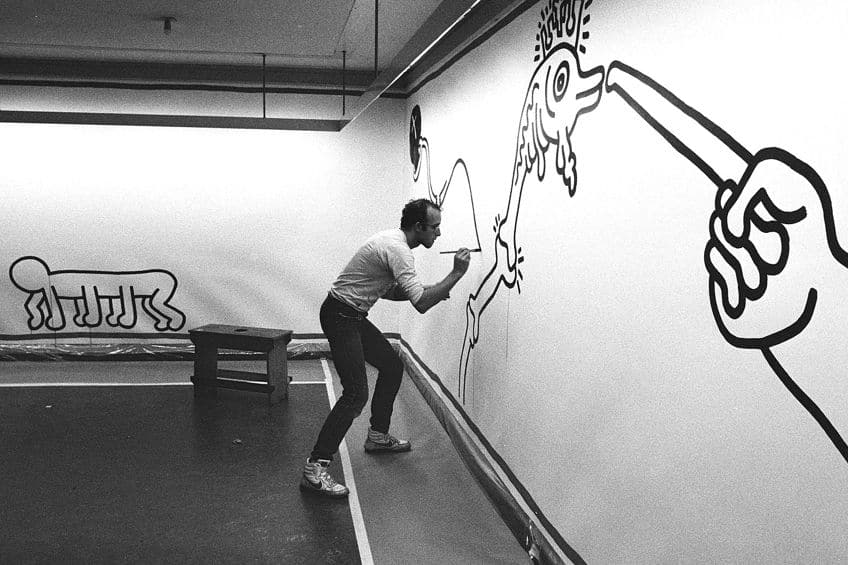
With that, we wrap up our list of famous line artists and artworks. As we have seen, artists that use lines all do so in their own unique manner. Therefore, our line art examples all differ substantially in style, yet all represent the multitude of distinct ways that line can be used in art.
Frequently Asked Questions
What Are Line Drawing Artists?
All artists use some form of line, so aren’t all artists line artists? Well, while the line is a fundamental aspect of art, line drawing artists tend to focus specifically on this principle, and utilize line as their main technique and element in their works. These artists are able to create compelling pieces of art without adding any color or shading.
Who Are Well-Known Artists That Use Lines?
Every well-known artist uses lines in their work, but some prefer to only use lines. However, many artists produce a multitude of different types of art, and making line drawings are simply another one of their abilities. These artists include Egon Schiele, Pablo Picasso, Sherrie Levine, Andy Warhol, and Henri Matisse.
Isabella studied at the University of Cape Town in South Africa and graduated with a Bachelor of Arts majoring in English Literature & Language and Psychology. Throughout her undergraduate years, she took Art History as an additional subject and absolutely loved it. Building on from her art history knowledge that began in high school, art has always been a particular area of fascination for her. From learning about artworks previously unknown to her, or sharpening her existing understanding of specific works, the ability to continue learning within this interesting sphere excites her greatly.
Her focal points of interest in art history encompass profiling specific artists and art movements, as it is these areas where she is able to really dig deep into the rich narrative of the art world. Additionally, she particularly enjoys exploring the different artistic styles of the 20th century, as well as the important impact that female artists have had on the development of art history.
Learn more about Isabella Meyer and the Art in Context Team.
Cite this Article
Isabella, Meyer, “Famous Line Artists and Artworks – A List of the 10 Best.” Art in Context. September 29, 2023. URL: https://artincontext.org/famous-line-artists-and-artworks/
Meyer, I. (2023, 29 September). Famous Line Artists and Artworks – A List of the 10 Best. Art in Context. https://artincontext.org/famous-line-artists-and-artworks/
Meyer, Isabella. “Famous Line Artists and Artworks – A List of the 10 Best.” Art in Context, September 29, 2023. https://artincontext.org/famous-line-artists-and-artworks/.





